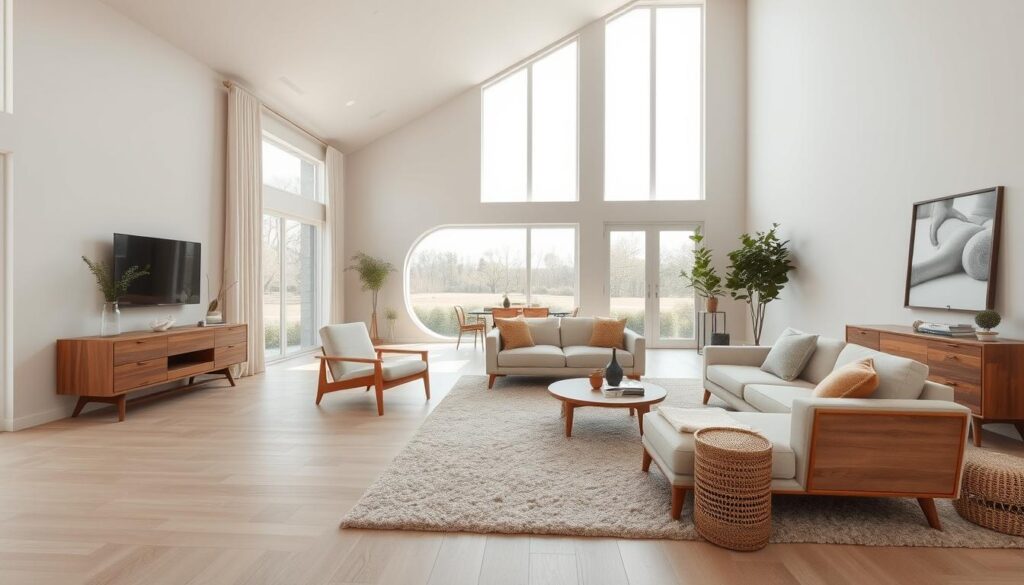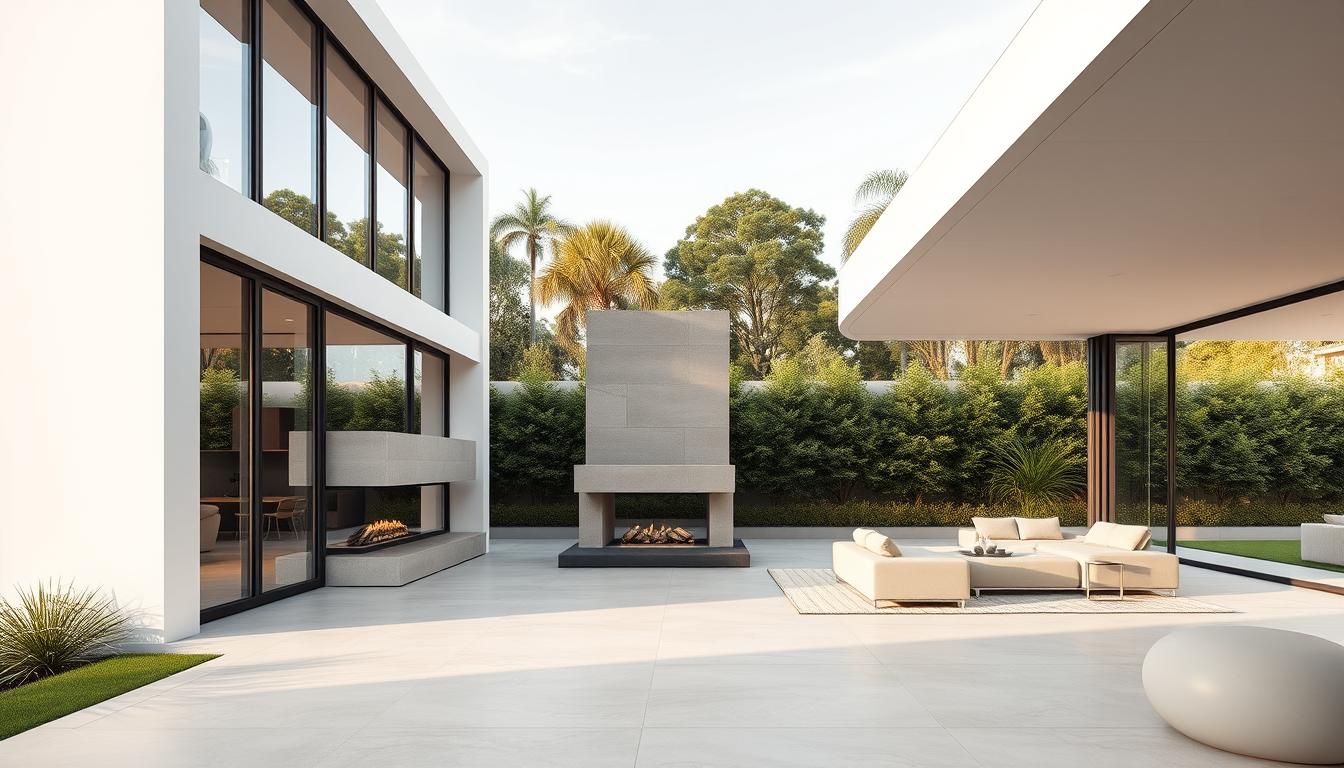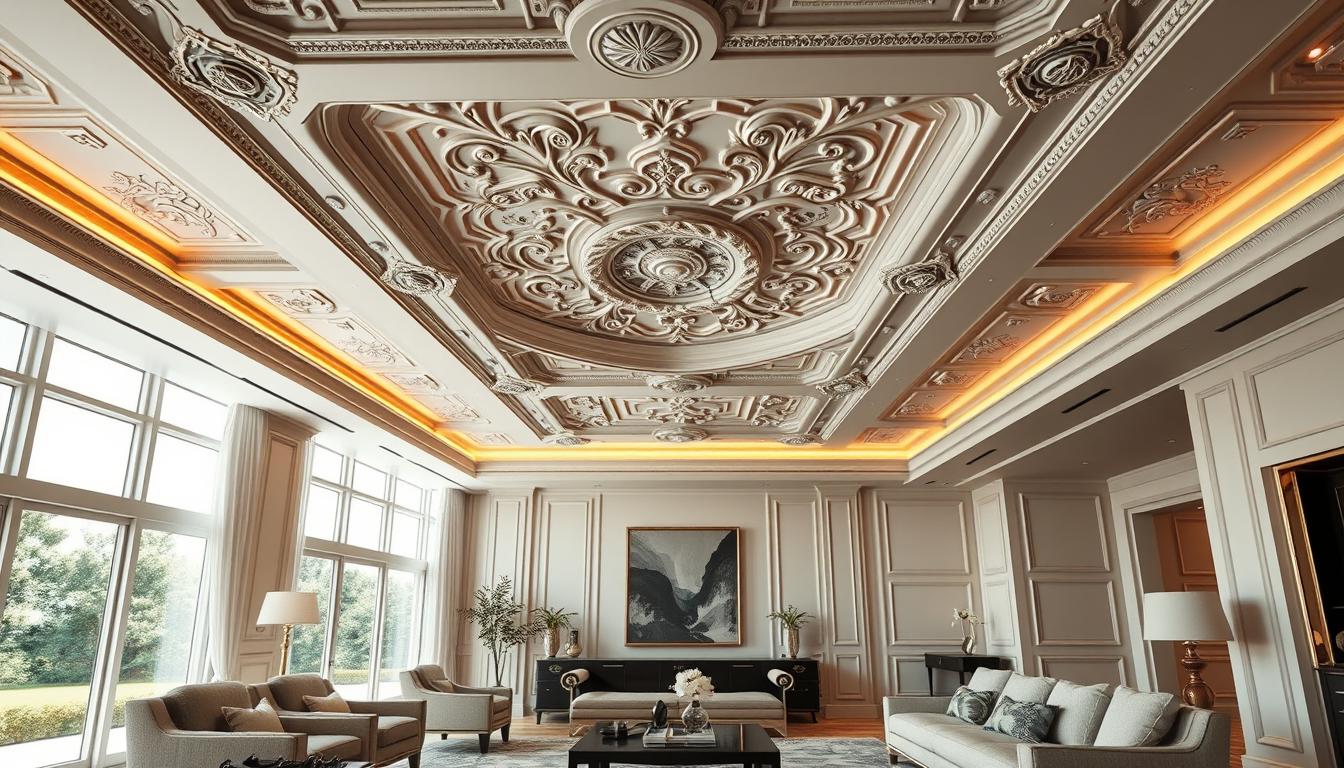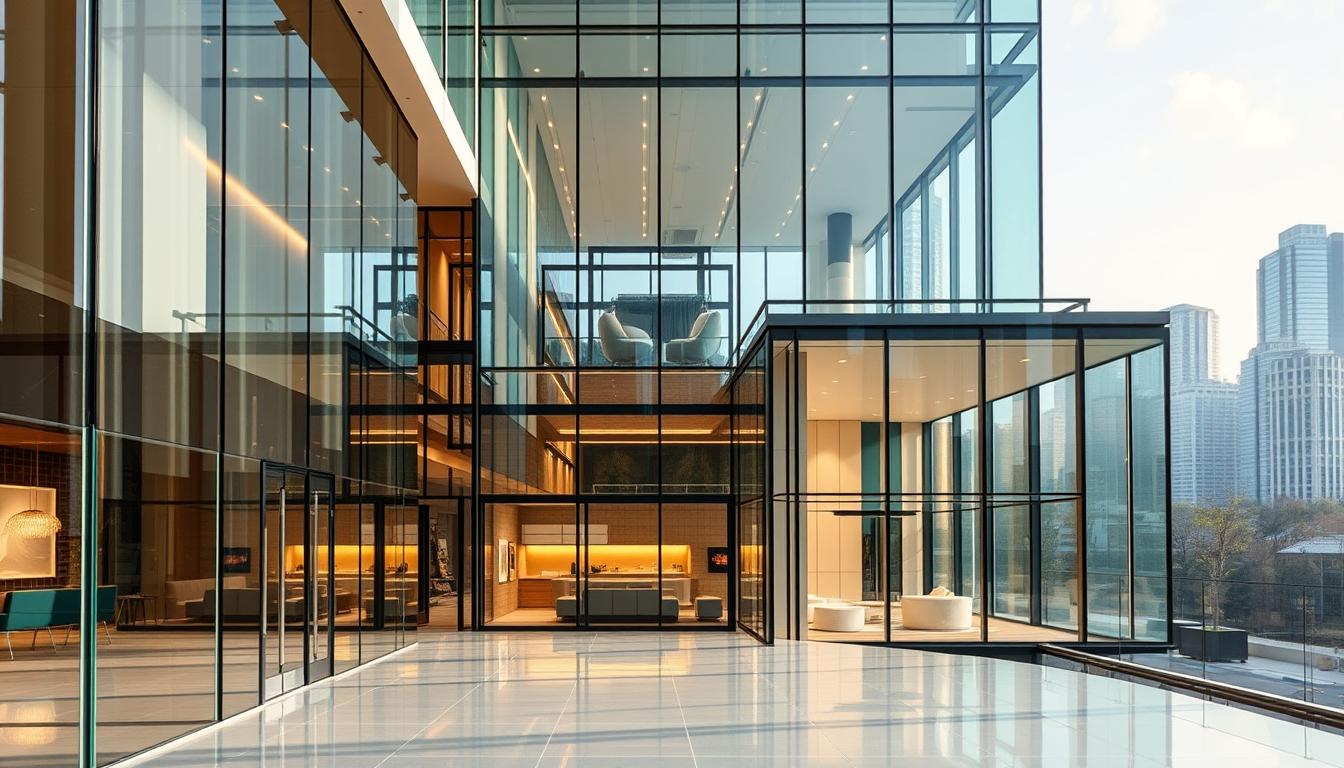Did you know the right interior design can really improve your mood and work? With so many design options, picking the perfect style for your space can feel hard.
We’ll look at the best modern home design and traditional decor ideas to change your space. We’ll cover everything from sleek and modern to cozy and eclectic. This will help you choose wisely.
Whether you want to update one room or your whole home, knowing the different interior home styles is key. Let’s explore the design world and find the perfect match for you.
Key Takeaways
- Understanding different interior design styles
- Key characteristics of modern and traditional decor
- Tips for choosing the right style for your space
- How to mix and match different styles
- Common mistakes to avoid in interior design
Understanding Interior Home Styles
Interior home styles are more than just design choices. They show our personal taste and change how our homes feel. Knowing what each style offers helps us pick the right one for us.
What Are Interior Home Styles?
Interior home styles are about how a home looks and works inside. They come from our culture, taste, and history. Popular styles include:
- Modern
- Traditional
- Contemporary
- Rustic
- Industrial
- Minimalist
- Eclectic
Each style has its own look, from colors and textures to furniture and decor. For example, modern interior style is all about simple lines, few decorations, and being useful.
Importance of Choosing the Right Style
Choosing the right style is key. It changes how our home looks and works. The right style can:
- Make our home look better
- Make our space more useful
- Show who we are
- Make us feel cozy and relaxed
By knowing the different styles, we can design our homes better. Whether we like contemporary interior trends or eclectic home decorations, we should pick what feels right to us.
Modern Interior Style
Modern interior style focuses on simplicity, functionality, and clean looks. It’s a favorite in luxury homes for its openness and calmness.
Key Characteristics of Modern Interiors
Modern home design has a few key elements:
- Clean lines and minimal ornamentation
- An emphasis on functionality and simplicity
- Sleek surfaces and neutral color palettes
- Use of natural light to enhance the sense of space
These elements create minimalist living spaces that are both elegant and practical. Modern interiors avoid clutter, focusing on what’s essential. This makes them calm and sophisticated.
Popular Color Palettes
Modern interior design often uses neutral tones like whites, blacks, and grays. These colors offer a clean base for modern decor.
Some favorite color combinations include:
- Monochromatic schemes with different shades of one color
- Complementary color schemes that mix contrasting colors for interest
- Analogous color schemes that use colors next to each other on the color wheel for harmony
Choosing a color palette that fits modern design principles helps create a stylish and welcoming space.
Traditional Interior Style
Traditional interior style is a timeless choice that brings warmth and sophistication to any home. It features classic furnishings, rich colors, and ornate details. Dark wood tones, luxurious fabrics, and antique pieces are common in traditional interiors.
https://www.youtube.com/watch?v=W93N8BBnquk
Defining Features of Traditional Design
Classic furnishings are key in traditional interior design. Think plush armchairs, ornate wooden furniture, and luxurious drapery. These elements create a warm, inviting atmosphere that’s both elegant and comfortable.
Rich colors are also crucial in traditional decor. Deep reds, rich greens, and warm neutrals are used to create a cozy, sophisticated ambiance. Adding antique pieces and ornate accessories can bring character and depth to your home.
Furniture and Decor Choices
Furnishing a traditional interior focuses on comfort and elegance. Look for pieces with intricate carvings, luxurious upholstery, and classic designs. For example, a velvet sofa or a wooden coffee table with ornate carvings can add sophistication to your living room.
For more inspiration, visit The Spruce. They offer a wealth of information on traditional decor ideas. Traditional style, while similar to rustic in using natural materials, focuses more on luxury and elegance.
Contemporary Interior Style
Contemporary interior style is always changing. It shows off today’s trends and tech. It’s not stuck in the past like some styles are.
Distinguishing Contemporary from Modern
Many people think contemporary and modern styles are the same. But they’re not. Modern design is from the early to mid-20th century. It’s all about clean lines and function.
Contemporary design is different. It’s all about mixing styles and trends. It’s more flexible and open to new ideas.
A key feature of contemporary interiors is their eclecticism. They mix different styles and materials. This makes each space unique and interesting.
Incorporating Contemporary Elements
To add contemporary style to your home, try these trends:
- Bold, statement lighting fixtures that add drama to a room
- Innovative materials and textures, such as metallic accents or reclaimed wood
- A focus on sustainability, using eco-friendly materials and energy-efficient solutions
- Open floor plans that create a sense of spaciousness and flow
For luxury homes, contemporary style is perfect. Use high-end materials and tech for a fancy look.
In short, contemporary interior style is great for modern homes. It’s flexible and stylish. By knowing its key features, you can make your home look modern and chic.
Rustic Interior Style
The rustic interior style celebrates the imperfect. It makes homes warm and welcoming. It’s perfect for those who love natural materials and the charm of age.
Elements of Rustic Design
Rustic interiors use earthy tones and distressed finishes. Reclaimed wood is key, adding warmth and character. Stone, brick, and vintage pieces also play a big role.
To get a rustic look, mix different textures and tones. For example, wooden beams with stone or brick look great together. Adding vintage furniture or unique decorations can also enhance the rustic vibe.
Ideal Materials for a Rustic Look
Choosing materials for a rustic interior means going for natural, raw options. Here’s a look at some top picks:
| Material | Characteristics | Uses in Rustic Design |
|---|---|---|
| Reclaimed Wood | Distressed finish, unique history | Furniture, flooring, wall paneling |
| Stone | Natural texture, durability | Fireplaces, wall cladding, flooring |
| Brick | Earthy tones, rustic charm | Exposed walls, fireplaces, outdoor kitchens |
For more on rustic design, check out The Spruce. They have lots of tips for making your home cozy and inviting.
Industrial Interior Style
The industrial interior style is perfect for those who love raw, unfinished looks. It turns old factories and warehouses into modern homes. This style is all about embracing the beauty of industrial spaces.

Characteristics of Industrial Interiors
Industrial design uses raw materials and simple decor. It features exposed brick, metal accents, and reclaimed wood. These elements add authenticity and ruggedness.
The color scheme is mostly neutral, with gray, brown, and beige. This lets bold art or vibrant furniture stand out.
Furnishing Your Industrial Space
Furnishing an industrial home needs a mix of rugged and cozy elements. Luxury home interiors can blend high-end materials with industrial looks.
Consider these tips:
- Choose furniture that’s both stylish and practical, like metal or reclaimed wood.
- Use lighting that fits the industrial vibe, like metal pendant lights.
- Add warmth with textiles and rugs.
Mixing industrial elements with modern home design creates a unique, welcoming space. It shows off your personal style.
Minimalist Interior Style
The minimalist interior style is all about simplicity and clean lines. It’s perfect for today’s homes. It focuses on the essentials and gets rid of clutter, making spaces calm and serene.
Principles of Minimalism in Home Design
Minimalist design is simple. It uses clean lines, minimal decor, and a few colors. This simplicity makes homes feel open and clear.
Functionality is key in minimalist design. Every item has a purpose, keeping spaces clutter-free and useful. This balance between form and function is what makes minimalist interiors work.
Benefits of Minimalism for Living Spaces
Minimalist interiors bring calm and relaxation. They reduce clutter and visual noise. This is great in today’s busy world, where homes are our retreats.
Also, minimalist design makes spaces look bigger. Using a few colors and less decor helps the space feel more open. This is great for small homes or apartments where space is precious.
Minimalist style is more than looks; it’s about a peaceful, organized, and functional home. As we deal with modern life’s challenges, minimalist design offers a simple yet elegant solution for better living spaces.
Eclectic Interior Style
The eclectic interior style is vibrant and celebrates individuality. It’s all about mixing different styles and periods. This approach encourages creativity and personal expression.
What Makes an Eclectic Space Unique?
An eclectic space is unique because it blends different elements well. This includes mixing vintage and modern pieces, using bold colors, and varied textures. The goal is to look cohesive despite the style and period differences.
For example, combining a vintage armchair with a modern sofa creates an interesting contrast. Adding bold, contemporary artwork or vibrant rugs can make the space even more eclectic.
Tips for Creating an Eclectic Interior
To create an eclectic interior, start by knowing your personal style. This might include vintage home decorations, modern trends, or unique house aesthetics.
- Begin with a neutral base to add pops of color and texture.
- Mix different styles and periods for visual interest.
- Don’t be afraid to add statement pieces, like bold artwork or unique furniture.
By following these tips, you can make a space that’s eclectic and truly reflects your personality and style.
Coastal Interior Style
The Coastal Interior Style brings the freshness and freedom of the coast into your home. It’s perfect for those who love the ocean’s serenity.
Defining Features
This style uses light colors and natural textures. These elements create a calm and relaxing atmosphere. You’ll find:
- Nautical accents like anchors, ropes, and navy blues
- Decor with driftwood and shells
- Blues and whites as main colors
- Natural materials like wicker and jute
Color Themes and Textures
The color palette is light and airy, with whites, beiges, and blues. These colors are paired with natural textures such as:
| Material | Texture | Use in Coastal Design |
|---|---|---|
| Wicker | Woven, natural | Furniture, baskets |
| Jute | Rough, earthy | Rugs, wall hangings |
| Driftwood | Weathered, smooth | Decorative pieces, furniture |
Interior design experts say, “Achieving a coastal look means balancing colors with natural textures and sea-inspired accents.” This style is more than looks; it’s about creating a tranquil atmosphere in your home.
“Coastal design is all about embracing the natural beauty of the coast and bringing it indoors.”
By adding these elements, you can make your home look and feel beautiful and serene. Whether you live by the ocean or just love the look, this style will bring calm to your space.
Farmhouse Interior Style
Farmhouse interior style brings the warmth of rural living into your home. It uses rustic elements, vintage pieces, and natural materials. This creates a cozy and inviting atmosphere.
Key Elements of Farmhouse Decor
Farmhouse decor includes shiplap, exposed beams, and antique furniture. These add to the rustic charm and character of the space.
- Shiplap: Adds a touch of rustic elegance to walls.
- Exposed Beams: Brings a sense of openness and authenticity.
- Antique Furniture: Provides character and history to the space.
Natural materials like wood and stone are key to farmhouse design. They enhance the organic feel of the interior.
How to Achieve a Modern Farmhouse Look
To get a modern farmhouse look, mix rustic elements with modern touches. Add sleek surfaces, minimalist decor, and bold accents to update the traditional style.
| Traditional Farmhouse | Modern Farmhouse |
|---|---|
| Rustic wood furniture | Sleek metal accents |
| Vintage decor | Minimalist decor |
| Earth tones | Bold color accents |
Design experts say, “The key to modern farmhouse design is finding a balance between old and new. This creates a space that feels welcoming and contemporary.”
“The modern farmhouse style is all about blending the old with the new, creating a unique and inviting space.”
By mixing these elements, you can make a farmhouse interior that’s stylish and functional. It’s perfect for modern living.
Mediterranean Interior Style
The Mediterranean interior style brings warmth and hospitality into your home. It uses warm, earthy tones and natural materials. This creates a cozy and inviting atmosphere.
Characteristics of Mediterranean Design
Mediterranean design often includes terracotta tiles, mosaic patterns, and wrought iron accents. These add visual interest and authenticity. Natural materials like wood and stone make the space warm and welcoming.
This style also features an eclectic mix of decorative items. You’ll find colorful ceramics, textiles, and traditional Mediterranean motifs. This mix creates a unique space that shows off the homeowner’s personality.
Colors and Patterns Commonly Used
The color palette in Mediterranean design is warm and vibrant. You’ll see terracotta, golden yellow, and deep blue. These colors are paired with intricate patterns in tiles, textiles, and more.
Patterns like geometric motifs and floral designs are common. They add depth and interest to the space. This creates a rich, layered look typical of Mediterranean style.
By using these elements, you can make your home Mediterranean-inspired. It can be a complete redesign or just a few touches. This style offers many ways to make your home warm and welcoming.
Transitional Interior Style
Transitional interior design mixes the best of old and new to create a harmonious space. It’s a flexible way to decorate, blending traditional and modern elements. This makes your home feel both personal and elegant.

Blending Elements from Different Eras
Transitional style combines different design elements for a unique atmosphere. This mix of old and new makes a space feel both timeless and modern. For example, a traditional sofa with modern coffee tables creates a striking contrast.
Choosing a neutral color palette is key when blending styles. It gives a versatile base for mixing different looks. Adding textures through rugs, throw pillows, and art makes the space feel richer and more complex.
Why Transitional Style Works Well
Transitional style is adaptable, fitting any space, from modern apartments to traditional homes. The balance between old and new brings calm and sophistication. It’s perfect for those who want a timeless look without being too strict.
This style is also forgiving, making it easy to update and change over time. As trends evolve, you can add new pieces to your décor. This keeps your home feeling fresh and current. We think this flexibility is a big plus, making it easier to keep your home stylish.
Tips for Choosing Your Interior Style
Choosing the right interior style for your home can be tough. But, by thinking about what you like and what your space needs, you can make a good choice. We’ll look at different styles, from modern to traditional, to help you find the best one.
Assessing Personal Taste
Your home’s style should show who you are and how you live. Think about what you like and dislike in different styles. For example, if you like simple designs, modern might be for you.
Visit our website to learn more about our services. We can help you get the interior style you want. Check out our services page to see how.
Considering Spatial Needs
The design of your home matters too. Traditional styles might fit a classic home better, while modern suits a newer space. Mixing your taste with your home’s needs creates a space that’s both beautiful and practical.


